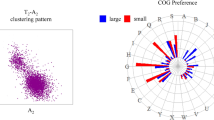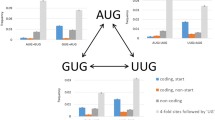Summary
A cluster analysis based on codon usage in genes for biological nitrogen fixation (nif genes) grouped diazotrophs into three distinct classes: anaerobes, cyanobacteria, and aerobes. In thenif genes ofKlebsiella pneumoniae there was no evidence for selection pressure in favor of highly translatable codons. However, in the nitrogen regulatory operonglnAntrBntrC of enteric bacteria the stoichiometrically high level of glutamine synthetase may be facilitated by the presence of efficiently translatable codons inglnA. Thenif genes of the cyanobacteriumAnabaena showed codon selection in favor of translational efficiency. Computation of codon adaptation indices for expression in heterologous systems indicated that the reading frames most suitable for expression ofnif genes inEscherichia coli, Bacillus subtilis, andSaccharomyces cerevisiae were present in azotobacters, clostridia, and cyanobacteria, respectively. In codon-usage-based cluster analysis, type 3 nitrogenase genes ofAzotobacter vinelandii grouped along with type 1 and type 2 genes. This is in contrast to the nucleotide sequence-based multiple alignment in which type 3 nitrogenase genes ofA. vinelandii have been reported to cluster with entirely unrelated diazotrophs such as methanogens and clostridia. This may be indicative of lateral transfer ofnif genes among widely divergent taxons. The chromosomal- and plasmid-locatednif genes of rhizobia also cluster separately in nucleotide sequence-based analysis but showed similar codon usage. These analyses suggested that the phylogeny ofnif genes drawn on the basis of nucleotide sequence homology was not masked by the taxon-specific pressure on codon usage.
Similar content being viewed by others
References
Arnold W, Rump A, Klipp W, Priefer UB, Puhler A (1988) Nucleotide sequence of a 24,206-base-pair DNA fragment carrying the entire nitrogen fixation gene cluster ofKlebsiella pneumoniae. J Mol Biol 203:715–738
Arunachalam J (1985) Pattern recognition approaches to the interpretation of analytical data. BARC Report I 842:288–313
Corpet F (1988) Multiple sequence alignment with hierarchical clustering. Nucleic Acids Res 16:10881–10890
Davies RG (1971) Computer programming in quantitative biology. Academic Press, London, p 420
Doron H, Zilberstein A, Covezensky D, Salomon D, Zamir A (1987) Nitrogenase molybdenum-iron protein subunits fromKlebsiella pneumoniae expressed in foreign hosts: characteristics and interactions. J Biol Chem 262:8814–8820
Gerband C, Elmerich C, Marsac NT, Chocat P, Charpin N, Guerineau M, Aubert JP (1981) Construction of new yeast vectors and cloning of theNif (nitrogen fixation) gene cluster ofKlebsiella pneumoniae in yeast. Curr Genet 3:173–180
Grosjean H, Fiers W (1982) Preferential codon usage in prokaryotic genes: the optimal codon-anticodon interaction energy and the selective codon usage in efficiently expressed genes. Gene 18:199–209
Gouy M, Gautier C (1982) Codon usage in bacteria: correlation with gene expressivity. Nucleic Acids Res 10:7055–7074
Ikemura T (1982) Correlation between the abundance ofEscherichia coli transfer RNAs and the occurrence of the respective codons in its protein genes. J Mol Biol 146:1–21
Ikemura T (1982) Correlation between the abundance of yeast transfer RNAs and the occurrence of the respective codons in protein genes. J Mol Biol 158:573–597
Ikemura T (1985) Codon usage and tRNA content in unicellular and multicellular organisms. Mol Biol Evol 2:13–34
Joergen RD, Jacobson MR, Premkumar R, Wolfinger ED, Bishop PE (1989) Nucleotide sequence and mutational analysis of the structural genesanfHDGK for the second alternative nitrogenase fromAzotobacter vinelandii. J Bacteriol 1079–1086
Jukes TH, Bhushan V (1986) Silent nucleotide substitutions and G+C content of some mitochondrial and bacterial genes. J Mol Evol 24:39–44
Mathur M, Tuli R (1990) Cluster analysis of genes for nitrogen fixation from several diazotrophs. J Genet 69:67–78
Miranda-Rios J, Sanchez-Pescador R, Urdea M, Covarrubias AA (1987) The complete nucleotide sequence of theglnALG operon ofEscherichia coli K12 Nucleic Acids Res 15:2757–2770
Ninfa AJ, Magasanik B (1986) Covalent modification of theglnG product NR1, by theglnL product, NR11, regulates the transcription of theglnALG operon inEscherichia coli. Proc Natl Acad Sci USA 83:5909–5913
Norel F, Elmerich C (1987) Nucleotide sequence and functional analysis of twonifH copies ofRhizobium ORS571. J Gen Microbiol 133:1563–1576
Normand P, Bousquet J (1989) Phylogeny of nitrogenase sequences inFrankia and other nitrogen-fixing microorganisms. J Mol Evol 29:436–447
Osawa S, Jukes TH, Muto A, Yammo F, Ohama T, Anadachi Y (1987) Role of directional mutation pressure in the evolution of the eubacterial genetic code. Cold Spring Harbor Symp Quant Biol LII:777–789
Raina R, Reddy MA, Ghosall D, Das HK (1988) Characterization of the gene for the Fe-protein of the vanadium dependent alternative nitrogenase ofAzotobacter vinelandii and construction of a Tn5 mutant. Mol Gen Genet 214:121–127
Reitzer LJ, Magasanik B (1983) Isolation of the nitrogen assimilation regulator NR1, the product of theglnG gene ofEscherichia coli. Proc Natl Acad Sci USA 80:5554–5558
Sharp PM, Li WH (1986) An evolutionary perspective on synonymous codon usage in unicellular organisms. J Mol Evol 24:28–38
Sharp PM, Li WH (1987) The codon adaptation index—a measure of directional bias, and its potential applications. Nucleic Acids Res 15:1281–1295
Sharp PM, Tuohy TMF, Mosurski KR (1986) Codon usage in yeast: cluster analysis clearly differentiates highly and lowly expressed genes. Nucleic Acids Res 14:5125–5143
Shields DC, Sharp PM (1987) Synonymous codon usage inBacillus subtilis reflects both translational selection and mutational biases. Nucleic Acids Res 15:8023–8040
Souillard N, Sibold L (1989) Primary structure, functional organization and expression of nitrogenase structural genes of the thermophilic archaebacteriumMethanococcus thermolithotrophicus. Mol Microbiol 3(4):541–551
Sueoka N (1988) Directional mutation pressure and neutral molecular evolution. Proc Natl Acad Sci USA 85:2653–2657
Tuli R, Mathur M, Vachhani AK, Iyer RK (1990) Nucleotide sequence analysis of genes for dinitrogen fixation and development of vectors forPlectonema boryanum. In: Proceedings of a national symposium on cyanobacterial nitrogen fixation. IARI, Delhi, pp 302–309
Zamir A, Maina CV, Fink GR, Szalay AA (1981) Stable chromosomal integration of the entire nitrogen fixation gene cluster ofKlebsiella pneumoniae in yeast. Proc Natl Acad Sci USA 78:3496–3500
Author information
Authors and Affiliations
Rights and permissions
About this article
Cite this article
Mathur, M., Tuli, R. Analysis of codon usage in genes for nitrogen fixation from phylogenetically diverse diazotrophs. J Mol Evol 32, 364–373 (1991). https://doi.org/10.1007/BF02101276
Received:
Revised:
Issue Date:
DOI: https://doi.org/10.1007/BF02101276




